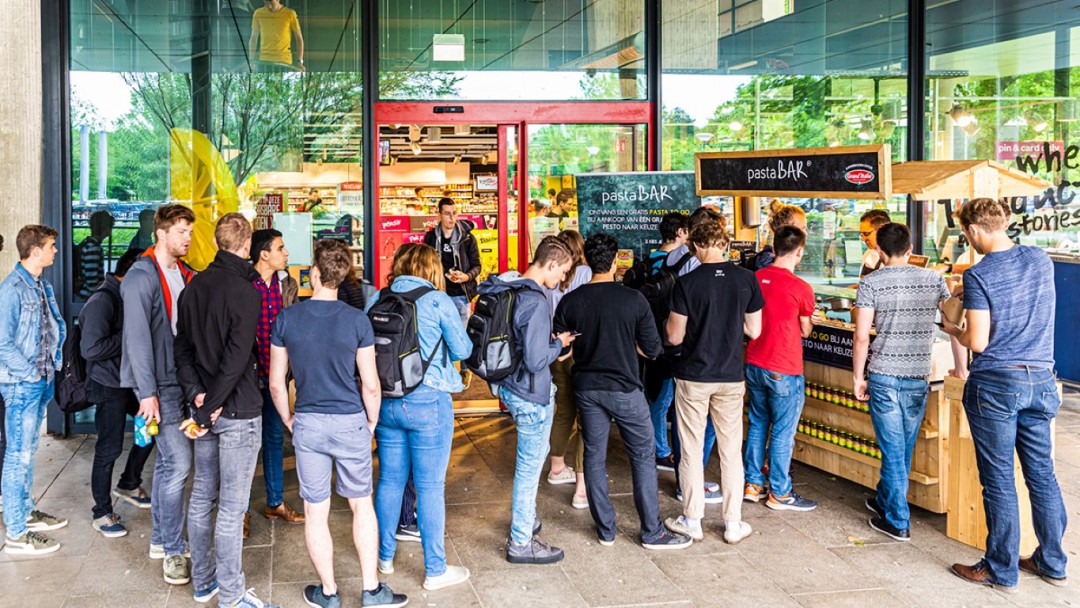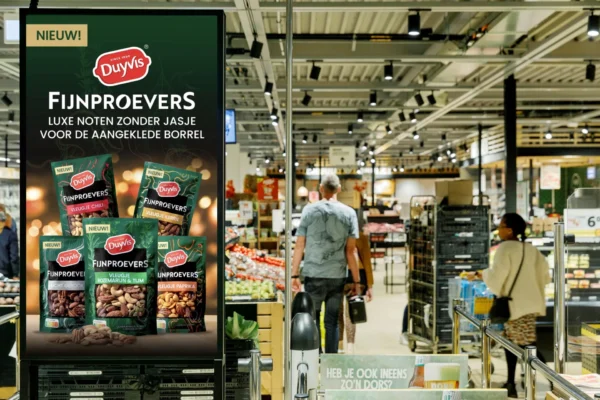
- News
- September 9, 2024
Fundamental Research: Instore Retail Media for Non-Endemic Brands

Brands understand the potential of instore retail media, but sometimes hesitate to take the leap.
Recently, RetailMedia.One, in collaboration with Centraal Beheer, MediaMarkt, JUMP! Retail, and talented students from the econometrics faculty, completed a fundamental study on the acceptance and effectiveness of instore retail media for non-endemic brands. This research was carried out with care and attention by all partners involved. Well done!
Most publications focus primarily on online advertising on websites and apps. Understandable, in a world dominated by Amazon, where clicks and impressions are easy to measure. However, the reach of traditional physical stores is still significantly larger than that of online platforms. Desk research shows that the physical retail network reaches about 7 times more people weekly, on average, than its online counterpart. So why are we constantly talking about online?
The Reach of Non-Endemic Brands
Can non-endemic brands leverage the massive reach of retail for their marketing campaigns? While brands recognize the potential of instore retail media, there is often hesitation—either from the brand itself or from their media agencies. One common argument is: “Won’t consumers find it strange to see my non-endemic brand’s commercial in a supermarket, electronics store, or department store?” This sounds like an excuse, as we see those same commercials around all sorts of TV shows. Additionally, brands are less consistent when it comes to advertising on social media or VOD platforms. The reality is, mental availability can come from anywhere. The goal is to be visible wherever large groups of (new) people gather. And guess what? Nowhere do more people gather than in the Dutch retail environment.
The Impact of Screens
According to a recent study by GroupM, Kantar, and MeMo2, the impact of instore high-impact advertising (large screens) scored an index of 114, outperforming the next best retail media touchpoint—storefront billboards, which scored 86. Clearly, instore retail media dominates in terms of impact.
For comparison, shopping mall billboards scored an index of 24. This means a modern, high-impact instore screen is about 4.75 times more effective than a shopping mall billboard. Sure, shopping mall billboards are often much cheaper, but they still can’t match the effectiveness (and costs) of instore advertising.
The Research Itself
The methodology of the fundamental study was simple. JUMP Retail/TBWA shortened Centraal Beheer’s TV/OLV commercial (Home Insurance) to 10 seconds and ran it for two days on MediaMarkt’s instore screens. On the first day, the commercial played on the regular advertising screens in-store. On the second day, the TV wall was also activated to provide extra exposure. The TV wall is a special feature where all in-store TVs display the commercial simultaneously.
The exciting part was to see whether the effects of day 1 differed from those of day 2 and to find out if a non-endemic commercial was recognized and welcomed by consumers. We also wanted to see if people who had seen the commercial on TV recognized it better in-store.
A total of 153 interviews were conducted over the two days. Here are the top 10 insights:
- MediaMarkt visitors are relatively young, with nearly half being 34 years old or younger. This retailer offers many opportunities to reach new audiences beyond traditional media.
- Dutch consumers have a generally positive view of instore advertising on large screens, as also shown in Kantar’s annual Media Reaction research.
- Instore advertising for non-endemic brands receives a positive to neutral response. However, younger consumers prefer the ability to purchase the product directly. The lack of a QR code, discount, or URL with a special offer in the ad lowered the overall appreciation.
- 23% of Dutch consumers prefer instore advertising as a form of advertisement.
- Awareness of the presence of advertising screens in-store was at 60%.
- Ad recognition was 62% on day 1 and 64% on day 2—high given that it was based solely on a single visit.
- On day 2, ad recall was 10 times higher. This shows that increasing exposure (using the TV wall) has less impact on recognition but significantly boosts recall.
- Younger consumers want to be able to act on what they see (branding campaigns could benefit from including transactional elements).
- There is clear synergy with TV advertising. Consumers who had seen the commercial on TV recognized the instore version significantly better—45% better, on average.
- About 30% of respondents had already seen the commercial on TV. This could be attributed to the younger audience that MediaMarkt attracts. Had this test been conducted in a store like Jumbo, Spar, or Hema, the synergy with TV might have been even stronger.
What Does This Research Tell Us?
While the specific implications are for the participating parties, in general, this study highlights the untapped potential of instore advertising. In a world where media effectiveness has been declining for over a decade, experimenting with a different media mix can yield significant results. The blue ocean of instore advertising for brand building is evident, with enormous reach and clear synergies with TV advertising.
The key is data-driven marketers, planners, and strategists who dare to explore new territory. A growing number of media agencies are recognizing the value of instore retail media for reach and impact. If any brands are interested in participating in future research, feel free to reach out to us at Marcel@RetailMedia.One.





